
- Power Transmission - Mechanical components
- Mechanical Transmission
- Spur gear
- Zahnradfabrik Hänel GmbH & Co. KG

- Products
- Catalogs
- News & Trends
- Exhibitions
Spur gear helical


Add to favorites
Compare this product
Characteristics
- Type
- spur
- Teeth
- helical
Description
Gearing with non-involute flanks is called special gearing. Involute gearing has a basic rack tooth profile in the form of a straight line, whereas special gearing does not. Nevertheless, special gearing and involute gearing are both produced using the hobbing method, which makes it possible to directly define various special gearings. A specially designed tool must then be used to make this special gearing. Generally, the tooth profile and the resulting geometry of the special gearing are determined via CAD. Based on the hobbing procedure, the appropriate mating gear can also be generated.
Compared to involute gearing, special gearing is difficult to standardize because the profile of the teeth also depends on the number of teeth on the smaller gear. For this reason, the tooth profiles of the gear pair must be precisely coordinated in order to guarantee ideal meshing and friction characteristics.
The teeth of a special gearing are often narrower at the root than the teeth of an involute gearing. Consequently, special gearings permit higher transmission ratios in a small space.
Cycloidal gearing is the most common type of special gearing. It is used in situations where the driving force creates propulsion from slow to fast speeds.
The reason non-involute gearing is sometimes preferred over involute gearing is because non-involute gearing has lower friction losses during slow to fast propulsion. Another advantage of cycloidal gearing is its greater tooth clearance, which makes it less susceptible to dust particles and dirt.
Other Zahnradfabrik Hänel GmbH & Co. KG products
Products
Related Searches
- Straight-toothed sprocket wheel
- Chain sprocket wheel
- Helical gear
- Spur gear
- Metal sprocket wheel
- Steel sprocket wheel
- Precision shaft
- Shaft gear
- Cylindrical gear
- Precision gear
- Single shaft
- Transmission shaft
- Transmission gear
- Stainless steel sprocket wheel
- Internal-toothed gear
- Stainless steel gear
- Drive shaft
- Single sprocket wheel
- Triple sprocket wheel
- Flange sprocket wheel
*Prices are pre-tax. They exclude delivery charges and customs duties and do not include additional charges for installation or activation options. Prices are indicative only and may vary by country, with changes to the cost of raw materials and exchange rates.









